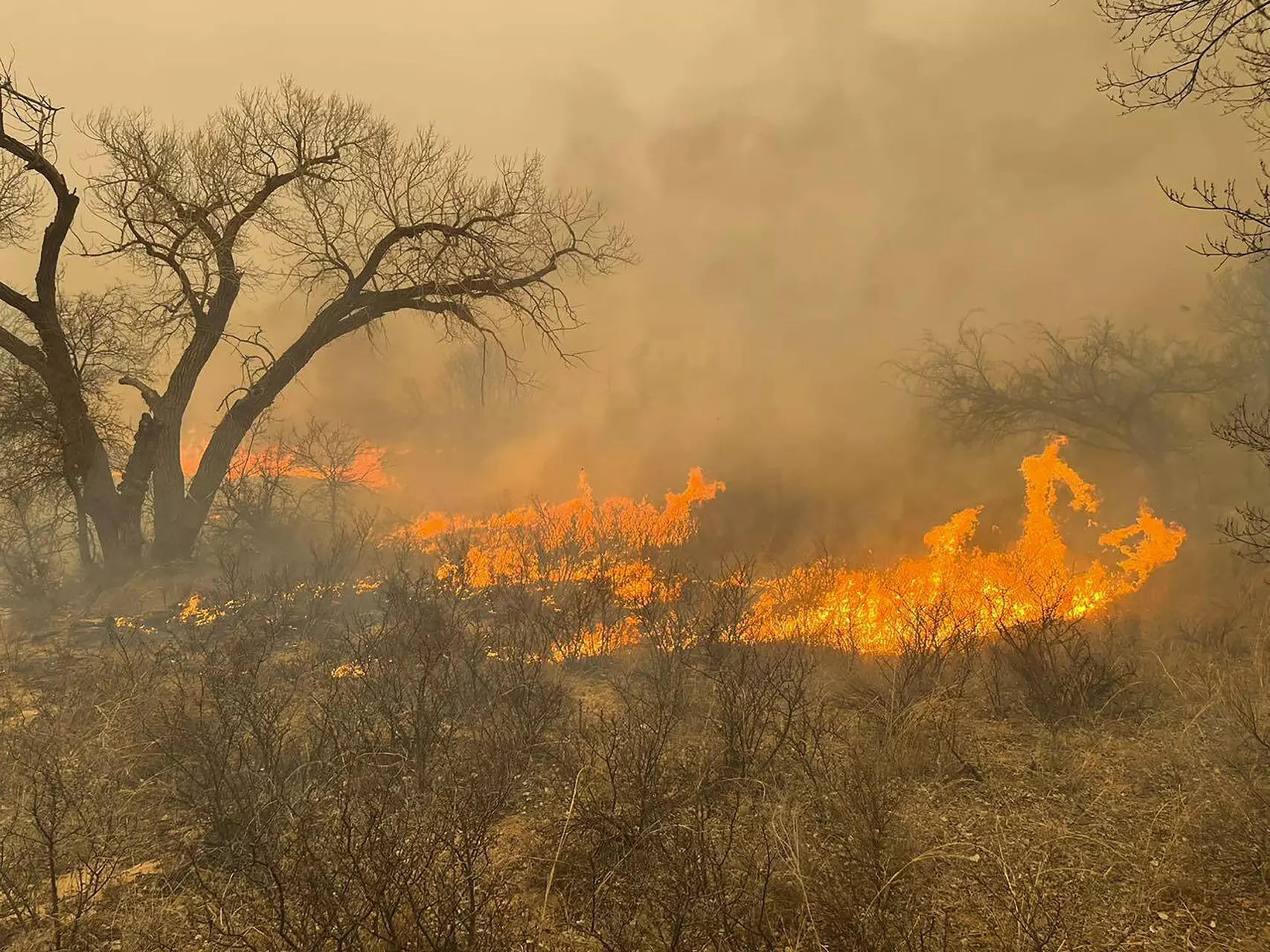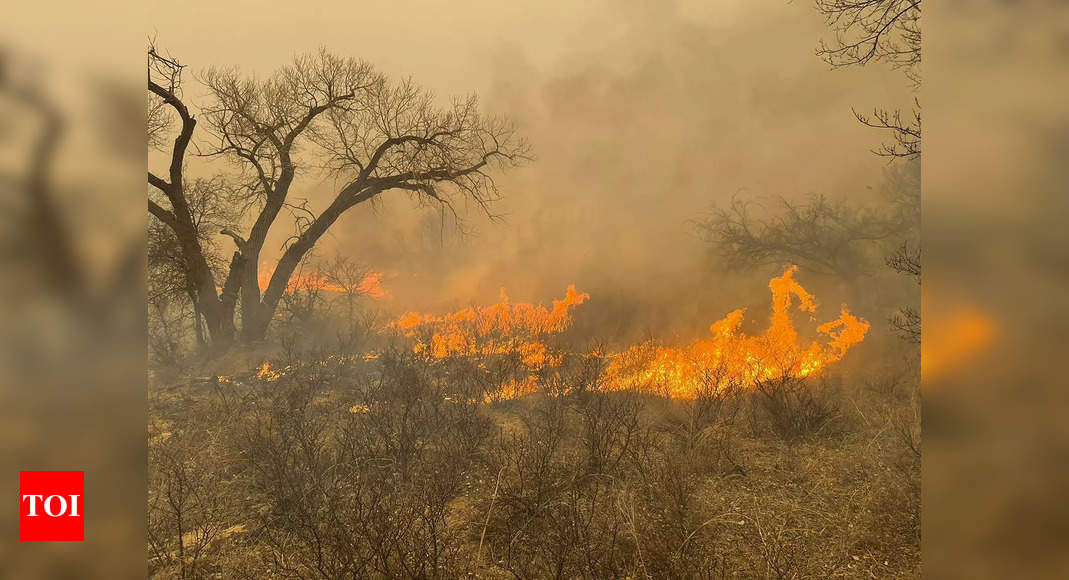
A cluster of wildfires ravaged the Texas Panhandle on Wednesday, with the Smokehouse Creek Fire becoming one of the largest in Texas history. Stretching over 1,300 square miles and spilling into Oklahoma, this massive blaze is currently only 3% contained, casting a dark shadow over communities and livestock across the region. Authorities are bracing for extensive damage, with the landscape described by some as reminiscent of a moonscape due to the severity of the burns.
Historic blaze challenges
The magnitude of the Smokehouse Creek Fire now surpasses that of the 2006 East Amarillo Complex fire, previously the largest in the state’s history.Despite the lack of immediate reports of death or injury, the potential for significant property and ecological damage remains high. Local residents recount harrowing escapes from the rapidly advancing flames, underscoring the fire’s unpredictability and ferocity.
Community impact and response
Approximately 40 homes were destroyed around Canadian, though the town itself was spared significant damage. The loss extends beyond property, with widespread fatalities among cattle, devastating local ranchers. The smaller community of Fritch, previously impacted by fires in 2014, faces yet another calamity, raising concerns about preparedness and recovery.
Causes and challenges
The fires, fueled by strong winds, dry conditions, and high temperatures, have challenged firefighting efforts and prompted widespread evacuations.
Very high winds and very dry conditions Monday provided “the perfect set up” for the fires, said Samuel Scoleri, a forecaster at the National Weather Service Amarillo office. Some areas in the Panhandle recorded winds upwards of 60 miles per hour (100 kilometers per hour), with even stronger gusts. There is usually a lot of wind in the area, and it has been intensely dry with relative humidity at 20% or even lower in some places.
The state’s response, led by Governor Greg Abbott, includes a disaster declaration covering 60 counties and a temporary halt to operations at a key nuclear weapons facility. Forecasts predict fluctuating conditions, with a possible break in the weather offering a brief respite for firefighters.
Emergency measures and precautions
As the fires continue to spread, emergency management officials stress the importance of readiness and adherence to evacuation orders. The response has been bolstered by community cooperation, but the ever-present threat of changing conditions keeps everyone on high alert. The containment efforts are complicated by the fires’ rapid spread and the unpredictable nature of wind-driven blazes.
What next
With cooler temperatures and potential rain on the horizon, there is hope that the tide may turn against the wildfires. However, officials caution against complacency, pointing to the forecasted return of fire-conducive weather. The community, while resilient, faces a long recovery ahead, with the immediate focus remaining on life safety and fire containment.
(With inputs from agencies)
Historic blaze challenges
The magnitude of the Smokehouse Creek Fire now surpasses that of the 2006 East Amarillo Complex fire, previously the largest in the state’s history.Despite the lack of immediate reports of death or injury, the potential for significant property and ecological damage remains high. Local residents recount harrowing escapes from the rapidly advancing flames, underscoring the fire’s unpredictability and ferocity.
Community impact and response
Approximately 40 homes were destroyed around Canadian, though the town itself was spared significant damage. The loss extends beyond property, with widespread fatalities among cattle, devastating local ranchers. The smaller community of Fritch, previously impacted by fires in 2014, faces yet another calamity, raising concerns about preparedness and recovery.
Causes and challenges
The fires, fueled by strong winds, dry conditions, and high temperatures, have challenged firefighting efforts and prompted widespread evacuations.
Very high winds and very dry conditions Monday provided “the perfect set up” for the fires, said Samuel Scoleri, a forecaster at the National Weather Service Amarillo office. Some areas in the Panhandle recorded winds upwards of 60 miles per hour (100 kilometers per hour), with even stronger gusts. There is usually a lot of wind in the area, and it has been intensely dry with relative humidity at 20% or even lower in some places.
The state’s response, led by Governor Greg Abbott, includes a disaster declaration covering 60 counties and a temporary halt to operations at a key nuclear weapons facility. Forecasts predict fluctuating conditions, with a possible break in the weather offering a brief respite for firefighters.
Emergency measures and precautions
As the fires continue to spread, emergency management officials stress the importance of readiness and adherence to evacuation orders. The response has been bolstered by community cooperation, but the ever-present threat of changing conditions keeps everyone on high alert. The containment efforts are complicated by the fires’ rapid spread and the unpredictable nature of wind-driven blazes.
What next
With cooler temperatures and potential rain on the horizon, there is hope that the tide may turn against the wildfires. However, officials caution against complacency, pointing to the forecasted return of fire-conducive weather. The community, while resilient, faces a long recovery ahead, with the immediate focus remaining on life safety and fire containment.
(With inputs from agencies)
Source link

